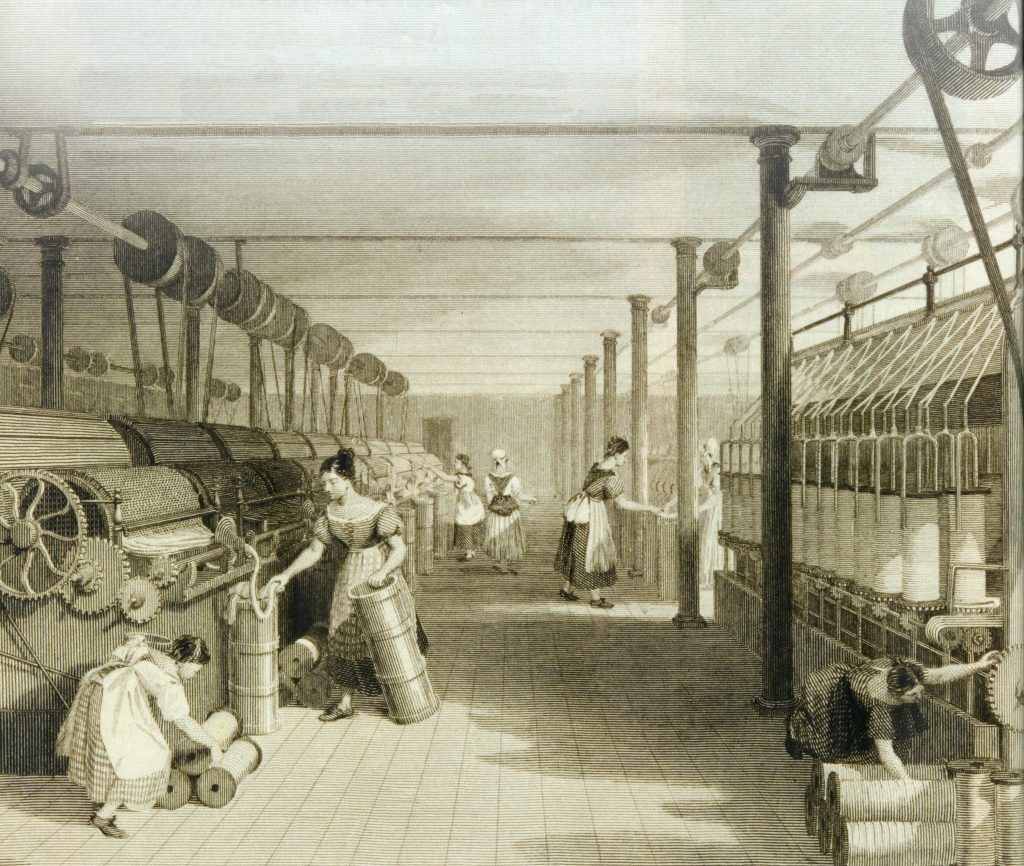Children today spend five days a week going to school for eight hours. During the first half of the nineteenth century in Britain, this was not the case. Instead, children even as young as five or six would toil all day long in factories or in mines. They had no breaks, no time off, and no schooling. Their work often led to horrible accidents, children being injured for life, and children left without an education.
Children laboring, of course, did not start with the British Industrial Revolution. It had been a normal part of life in Europe since the middle ages, when children helped their parents on farms and with household work. The people’s perception of this work, however, changed during the Industrial Revolution, since that is when people began to see this new kind of labor, factory labor, as an injustice and even criminal.1
The Industrial Revolution began in Britain during the 1780’s and rapidly changed the work process and the social relations of work. Prior to the Industrial Revolution, most people worked directly in the production of food, usually as farmers on their own farms. When textile factories began forming in the new factory cities, instead of working on their farms and making what their family needed, people left their farms and moved into the factory cities to make a living. Factory conditions of work, however, were far different from the work rhythms of farm life. In fact, they were brutal in comparison. Factory workers would typically put in between 12 and 16 hour days, working for meager wages. The machines they attended were dangerous, and the workers were often on their feet throughout the day, with perhaps a half-hour break for meals. Among these workers were children, many of whom were as young as five or six years old. Children were valued as workers for their small stature and ability to climb into small places and do things that adults often could not do. This often resulted in mutilation and the loss of appendages for many of these children.2
Children were also valued as workers by the factory owners because of the low wages that they were paid. Men were paid the most in factories, followed by women and then children. These wages, however small, were needed by the families of these children simply to survive. The parents often sent their children out to work to help pay for rent, food, and otherwise help make ends meet.3
One reason that the British public became outraged by child labor practices was the fact that children in factories were not receiving an education. Horace Mann, an American educational reformer, stated:
No greater calamity can befall us as a nation than that our children should grow up without knowledge and cultivation. If we do not prepare them to become good citizens, develop their capacities, enrich their minds with knowledge, imbue their hearts with a love of truth and all things holy, then our republic must go down to destruction as others have gone before it.4
This represents the thoughts of the British at the time, which was being echoed in the United States during its own industrial revolution. People wanted to ensure the future of their nation, which starts with the young. They believed that children should attend school for at least a while.5 This led to several laws being passed to raise the legal age of work.
In 1833, the British Parliament passed the Regulation of Child Labor law to help improve the working conditions for children in factories. The Law limited the age of workers, saying that they had to be older than nine with an age certificate to prove it, and that children 9-13 could not work for more than nine hours a day. Additionally, children 13-18 were not permitted to work longer than twelve hours a day. Along with these work-hour restrictions, the law also made school attendance a two-hour requirement, and said that children could not work at night. Fines for breaking these rules were small, however, so they were frequently violated, often with impunity.6

Many other pieces of legislation were also passed to place limits on the gender, hours, and ages of workers. The Mining Act of 1842 prevented women and girls from working in mines, and the Ten Hours Bill of 1847 set ten as the maximum number of daily working hours for women and children. This act was hated by factory owners because they believed it would hurt the textile industry’s competitiveness worldwide. After these bills, others followed to ensure their effectiveness, and to ensure that they would be properly implemented.7
By 1900, the minimum working age had been raised to twelve years of age and child labor had decreased drastically in Great Britain. However, the introduction of legislation against child labor provoked its share of protests as well. Because of these protests, Parliament established commissions to collect evidence of abusive practices. These were called the Blue Books or Sadler Reports. They interviewed children, parents, factory workers, owners, and even doctors on the condition of children in textile factories. Unsurprisingly, the reports uncovered a range of serious abuses by factory owners and overseers. Unfortunately, most critics just said that the claims were exaggerated in order to continue their money making practices.8
The legislation surrounding the British Industrial Revolution had become very effective by 1900, and child labor and its accompanying abuses had decreased dramatically. By 1900, most children were attending school instead of working in factories. The laws passed finally added up to changing British child labor to being closer to what we see today, a mostly child-free labor system, with children going to school and adults having regulated working hours.
- World History Encyclopedia, 2011, s.v. “Child Labor and Child Labor Laws in Early Industrial Great Britain.” ↵
- James D. Schmidt, “Broken Promises: Child Labor and Industrial Violence,” Insights on Law & Society, no. 3 (Spring 2010): 14–17. ↵
- Robert Whaples, “Hard at Work in Factories and Mines: The Economics of Child Labor during the British Industrial Revolution,” Business History Review, no. 2 (2001): 429. ↵
- Friends’ Intelligencer vol. 28 no. 1 (1871): 336. ↵
- James D. Schmidt, “Broken Promises: Child Labor and Industrial Violence,” Insights on Law & Society, no. 3 (Spring 2010), 14–17. ↵
- Great Britain, “Factories Regulation Act” (1833). ↵
- Steven Toms and Alice Shepherd, “Creative Accounting in the British Industrial Revolution: Cotton Manufacturers and the ‘Ten Hours’ Movement,” MPRA Paper, No. 51478 (2013), 6-8. ↵
- World History Encyclopedia, 2011, s.v. “Child Labor and Child Labor Laws in Early Industrial Great Britain.” ↵



141 comments
Paula Ferradas Hiraoka
It’s amazing but at the same time sad how families can “sacrifice” their children for work. While reading this article I learned several things and made me remember others teached in class. It is very sad to hear that they were forced to go hours without a break, no time off, or schooling. Education is important, so I am glad that someone invented laws for the benefit of the kids.
Aurora Torres
Great Article! Hard to believe that children as young as 5 years old were working already and not being paid well either. It is sad that the Industrial Revolution caused so much abuse for innocent children. Money and greed was the main focus for this kind of treatment. I understand that times were different but parents allowing for their children to work was wrong putting them in dangerous environment where they had to risk their lives everyday to help pt food on the table and a roof over their own heads. Glad that changed and children were no longer able to work and instead get an education. Without them getting educated right where would we be now. Like your article the quote from Horace Mann, every word he said is true.
Grace Malacara
It’s hard to read about children being forced to work in such harsh conditions. This article was really well written and informative about the atmosphere surrounding child labor during the Industrial Revolution. For a while, during the Industrial Revolution, it wasn’t frowned upon to send a child to work. You did a great job highlighting the difficulties children faced during this time.
Paula Ferradas Hiraoka
It’s amazing but at the same time sad how families can “sacrifice” their children for work. While reading this article I learned several things and made me remember others teached in class. It is very sad to hear that they were forced to go hours without a break, no time off, or schooling. Education is important, so I am glad that someone invented laws for the benefit of the kids.
Jesslyn Schumann
This article was written very well. The way the author went into depth about how intense these conditions were and how it was affecting the children working in these factories. I did not realize how many times the law was changed when it came to child labor laws. The author put a lot of information within this story that helped the reader understand how Britain was trying to change the laws and the extent of each. Wonderful story!!!
Andrea Ramirez
The information in this article was very impressive. I am glad how, throughout history, working conditions have improved to the point where we are today. It was quite abusive and advantageous on the part of people back then to use children for work, especially because they exploited and mistreated them. I was very surprised that at the age of 5 they were already suffering from such working conditions. So, I am glad that people could open their eyes and see this kind of abuse and injustice, and take action to abolish it.
Nice job!
Victorianna Mejia
This was an amazing read from start to finish! It kept me engaged and outraged at the same time. I have always known about child labor laws and why they were implemented. However, I was not informed about the ages of these children. For some reason, I always believed they were much older than five years old. I believed most were at least the age of ten when they started working. This article is informative and I believe very important to society’s history. Great job!
Nooraldeen Aldrees
The author gave his article a very good appealing title that caches the eye. Naming the article Children without a Childhood brings an emotional sense to this tragedy, child labor. Also, the introduction itself was an intelligent way of introducing the subject. The author brought the reader what they know now, how most children live today, to how it was two-hundred years ago, which I believe a very smart way to start the article. Also, the author did an excellent job in detailing the different age group and their working hours. Usually when an author mentions a legislation would only mention the title of the law without going in details in how that law was implemented. But, in this article the author explained the law, and brings the social attitude toward the law, and how it was applied. To do that, the author must be a meticulous researcher. He did not only name the law but explained it with the social implication. Great article.
Andrew Ponce
The author put together a very well written article, where it informed the reader a lot about the conditions children were in during this age. The article interestingly takes the audience through the stages of how children began working and how society caught up with the immorality of the conditions and fixed the issues presented. Very well written article !
Mauricio Rebaza Figueroa
I think this article explained really well made with a big amount of information that can make you realize how lucky you are not to suffer these conditions child workers had to go through during Industrial Revolution all around the world because of how deregulated was the labor space. Good use of images and sources that make this article trustable. Very good job.